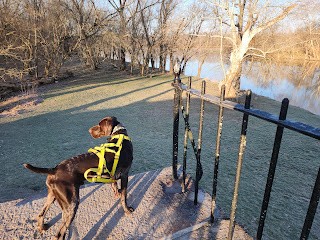Providence Spring of Andersonville prison, the largest and most famous of 150 military prisons of the Civil War.
NAVDHA VC, U-Ch, U-CD, U-WPCH Friedelsheim's Boozie Tim certified mantrailer GAK9 & AMPWDA, MH, IPO-R MT-V, BH, CD
Monday, February 26, 2024
Thursday, February 22, 2024
Wednesday, February 21, 2024
10 quick miles before work
It was a quiet section of the trail and the fact that we began at sunrise, it was 23 degrees, and a week day. We saw just one other intrepid trail user and also a red tail hawk, pair of wood ducks, a Carolina wren, and several cardinals.
Sunday, February 18, 2024
Best fun for 24 degrees
Easy ride on a cold morning.
Mile marker 50.0
Point of Rocks Trail Tunnel
The rivalry between the C&O Canal and the B&O Railroad came to a head in the mid 1800s when continuation of both the Canal and the railroad tracks required passage through the narrow Point of Rocks section of the Potomac River basin. The B&O bought up much of the land in this stretch, but the C&O countered with a claim that it had the rights to the route based on a previous charter. It was eventually ruled the C&O Canal must share the right of way with the railroad as far as Harpers Ferry. To provide a little more breathing room through this very tight squeeze, the railroad built tunnels through two spurs of the Catoctin ridge following the Civil War. Once the Canal was out of business, the B&O ran tracks around the outside of the tunnels as well, and the Canal unfortunately became a dumping ground for the railroad. (Source: www.canaltrust.org)
Mile marker 48.2
Point of Rocks Railroad Station
The Point of Rocks Railroad Station, considered one of the most picturesque railroad depots in the nation, was built when the B&O’s connector line to Washington was constructed in the late 1860s. Its location, where the two lines meet, is truly unique. The station is unusually sophisticated for its rural setting, done in the Victorian Gothic Revival style. The station is a testament to the significance of the railroad in post-Civil War America. It was placed on the National Register of Historic Places in 1973 and is still used by CSX, the successor to the B&O Railroad, as an office. (Source: www.canaltrust.org)
Sunday, February 11, 2024
Back to C&O, double dip AT too
Cloudy drizzly warm winter day. Saw many types of passerines, Canada geese, kayakers, fisher people, crazy off leash GSPs, and a woman who yelled at me for making him run.
Placement at first feild trial
Super fun weekend playing NSTRA. Boozie and I need a few more skills to do well consistently but taking second at our first feild trial wasn...

-
Trail aged two hours in an always busy with vehicular and pedestrian traffic area but due to ice skating and other holiday festivities it wa...

.jpg)
.jpg)
.jpg)






















